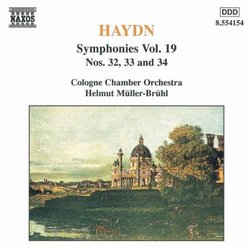| All Artists: Franz Joseph Haydn, Helmut Müller-Brühl, Cologne Chamber Orchestra Title: Haydn: Symphonies, Vol. 19 Members Wishing: 0 Total Copies: 0 Label: Naxos Release Date: 5/26/1998 Genre: Classical Styles: Historical Periods, Classical (c.1770-1830), Symphonies Number of Discs: 1 SwapaCD Credits: 1 UPC: 636943415429 |
Search - Franz Joseph Haydn, Helmut Müller-Brühl, Cologne Chamber Orchestra :: Haydn: Symphonies, Vol. 19
 | Franz Joseph Haydn, Helmut Müller-Brühl, Cologne Chamber Orchestra Haydn: Symphonies, Vol. 19 Genre: Classical
|
Larger Image |
CD Details |
CD ReviewsVery Good! R. A. Odefey | Martinsburg, WV | 03/25/2007 (4 out of 5 stars) "We enjoy Haydn, and have a lot of his music. Anyone who enjoys this composer will enjoy this. Good quality and value." Exploring the Haydn Symphonies -- Nos. 32, 33, and 34 Robin Friedman | Washington, D.C. United States | 05/01/2004 (5 out of 5 stars) "This disk is part of a complete recording of the Haydn symphonies on Naxos, an excellent budget level, and features three early symphonies, nos. 32, 33, and 34. Naxos uses a variety of conductors and orchestras in this series. The symphonies in this volume are performed by the Cologne Chamber Orchestra conducted by Helmut Muller-Bruhl. They give a fine performance of these rarely-heard works, which are written to be played by a small orchestra. Haydn composed the first two of these symphonies while employed as Kappelmeister by one Count von Morzin. Thus, these works predate, the better-known part of Haydn's output which dates from his employment by Prince Esterhazy in 1762.Symphony No. 32 and Symphony No. 33 are both in C major and probably were composed in 1750. Although both symphonies have a festive character, each is an individual work and worth hearing on its own.Symphony no. 32 is the more lively and vigorous of the pair. The opening movement, an allegro molto, is angular in character and features the trumpet together with flourishing rolls on the tympani. The second movement is a modestly-paced menuet with a theme in the strings and a continued prominent role for the brass. The trio is much more spare and features a duet between upper and lower strings. The third movement, marked adagio ma non troppo, is a flowing andante in the strings. It is serene in character. The finale returns to the vigor of the opening movement with a rapid theme in the strings punctuated by the brass leading to a rousing close.I found the symphony no. 33 more subdued. The opening movement, a vivance, is lively and, as does its predecessor, features the trumpet, but the movement is on the whole more flowing and lyrical. Haydn here reverses the order of the second and third movements, almost as if he is experimenting with the placement of the slow movement and the menuet. Although the slow movement here is marked "andante" it is much slower in pace the the slow movement in no. 32. It is spare, and rather longish, in character featuring the strings alone. The menuet opens with a modestly paced, stately theme in the strings with subdued brass in the trio. The finale opens with an emphasized beat of the tympani followed by a skipping theme. This is a delightful work, considerably quieter that the 32nd symphony.The final work on this CD, the Symphony no. 34 in D minor, dates from 1765 when Haydn was employed by Prince Esterhazy. This is Haydn's first minor-key symphony and is similar to Haydn's earlier symphony no. 22 -- the "Philosopher". As is the earlier work, symphony no. 34 is written in the mode of a church sonata, an ancient form even during Haydn's time, with the first and third movements as slow movements and the second and fourth as fast movements.The opening adagio is reflective and melancholy with a long, winding theme. The second movement is an allegro which opens with a theme in the strings and a following theme featuring the oboe. (This movement reminded me of an instrumental interlude in a Gluck opera.) The third movement menuet opens with a falling five-note theme in the violins followed by a theme accompanied by the lower strings. The trio is brighter and features a duet between the oboe and horns. The finale is a skipping movement in triplets. It is fortunate to have the opportunity to explore on budget discs Haydn's varied symphonic output. These early Haydn symphonies will delight the listener."
|

 Track Listings (12) - Disc #1
Track Listings (12) - Disc #1